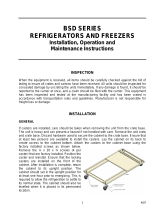
19
Specication Line
Maintenance
Door Gasket Maintenance
Door gaskets require regular cleaning to prevent mold and
mildew build up and also to retain the elasticity of the gasket.
Gasket cleaning can be done with the use of warm soapy water.
Avoid full strength cleaning products on gaskets as this can
cause them to become brittle and crack. Never use sharp tools
or knives to scrape or clean the gasket. Gaskets can be easily
replaced and do not require the use of tools or an authorized
service person. The gaskets are “Dart” style and can be pulled
out of the groove in the door and new gaskets can be “pressed”
back into place.
Drain Maintenance - Base
Each unit has a drain located inside the unit that removes
the condensation from the evaporator coil and routes it to an
external condensate evaporator pan. Each drain can become
loose or disconnected during normal use. If you notice water
accumulation on the inside of the unit be sure the drain tube
is connected to the evaporator drain pan. If water is collecting
underneath the unit make sure the end of the drain tube is in
the condensate evaporator in the machine compartment. The
leveling of the unit is important as the units are designed to
drain properly when level. Be sure all drain lines are free of
obstructions.
Drawer Maintenance
Drawer Assembly Cleaning
The drawer assembly is designed to be cleaned easily. Both
drawer and tracks are removable without tools. The drawer
tracks are dishwasher safe or can be cleaned in a sink with
detergents and a soft bristle brush. Drawers and tracks should
be cleaned on a weekly basis.
Remove Drawers
Pull the drawer box out until it stops. Lift up on the drawer front
and pull the drawer box completely out. Using a soft bristle
brush, clean the track on the bottom of the drawer box. When
finished, it should be wiped clean of all food and debris.
Tracks
The drawer box assembly must be removed. Pull the drawer
tracks out until they hit a stop. Locate blue safety clips towards
the back of each drawer track. Blue safety clips have a tab on
the top. Push the tab back until it clicks. Lift up and pull the
drawer tracks all the way
out of the drawer cage.
The drawer tracks are
dishwasher safe or can
be cleaned in a sink with
detergents and a soft
bristle brush. Drawers
and tracks should be cleaned on a weekly basis. Using a
soft bristle brush, wash the track making sure each roller is
thoroughly cleaned. The drawer cage should be cleaned with
a soft bristle brush, removing any food and debris gathered
on the bottom ledge. Once it’s cleaned thoroughly with a soft
bristle brush, wipe remaining debris clean with a soft towel.
Reassembly
Push the drawer tracks into the drawer cage. The blue safety
clip must remain pushed towards the back. Lift up and slide the
drawer track all the way into the drawer cage. The blue safety
clip will lock in place automatically. Once all tracks are replaced,
insert the drawer box. Rest the drawer box bottom track on the
front track roller. Then push the drawer back in place SLOWLY.
When the drawer box is about half way in you will hit a STOP.
You must lift the front of the drawer up approximately ½”
(1.3cm) to continue inward. Clean tracks as often as possible.
The cleaner the tracks are the better they will operate.
Caster Maintenance
Wipe casters with a damp cloth monthly to prevent corrosion.
The power switch must be turned to OFF and the
unit disconnected from the power source whenever
performing service, maintenance functions or
cleaning the refrigerated area.
Refrigerators and Freezers
The interior and exterior can be cleaned using soap and warm
water. If this isn’t sufficient, try ammonia and water or a
nonabrasive liquid cleaner. When cleaning the exterior, always
rub with the “grain” of the stainless steel to avoid marring the
finish. Do not use an abrasive cleaner because it will scratch the
stainless steel and can damage the breaker strips and gaskets.
Stainless Steel Care and Cleaning
To prevent discoloration or rust on stainless steel several
important steps need to be taken. First, we need to understand
the properties of stainless steel. Stainless steel contains 70-
80% iron, which will rust. It also contains 12-30% chromium,
which forms an invisible passive film over the steel’s surface,
which acts as a shield against corrosion. As long as the
protective layer is intact, the metal is still stainless. If the film
is broken or contaminated, outside elements can begin to
breakdown the steel and begin to form discoloration or rust.
Proper cleaning of stainless steel requires soft cloths or plastic
scouring pads.
NEVER USE STEEL PADS, WIRE BRUSHES OR SCRAPERS!
Cleaning solutions need to be alkaline based or non-chloride
cleaners. Any cleaner containing chlorides will damage
the protective film of the stainless steel. Chlorides are also
commonly found in hard water, salts, and household and
industrial cleaners. If cleaners containing chlorides are used be
sure to rinse repeatedly and dry thoroughly. Routine cleaning
of stainless steel can be done with soap and water. Extreme
stains or grease should be cleaned with a non-abrasive cleaner
and plastic scrub pad. Always rub with the grain of the steel.
There are stainless steel cleaners available which can restore
tab on top of
blue safety clip






















